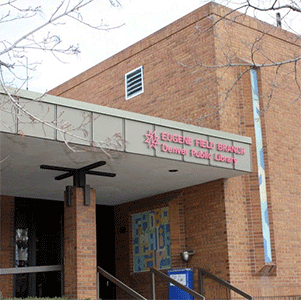Overview

Renovation construction includes:
- Exterior work including: parking, landscaping, sidewalks, exterior lighting,and creating an exterior storage area
- Redesign of the entrance and book return
- Improvement of building systems, including: HVAC, restrooms, life safety, surveillance, access control, IT, communication systems, electrical & lighting
- Updating and improving the community room, flexible learning spaces, youth spaces, staff spaces, and ADA accessibility
- New finishes, furniture, fixtures, and signage.
Address: 810 South University Boulevard
Year opened: 1970
Last renovation: 1994
Square footage: 10,500 sq. ft.
History
The Eugene Field Branch Library, named after American writer Eugene Field, was dedicated in March 1970 and has been an important hub of activity for the University Park and Bonnie Brae neighborhoods ever since. It was one of the first branch libraries to provide film and record loans as well as fine art rental. The library was designed by Denver architect Oluf N. Nielsen and underwent a major renovation in 1993-94.
The branch serves an affluent community comprised of singles, married couples without children and families with children across a range of ages. This population uses both the branch and the library’s virtual services. The branch’s collection and programs reflect the interests and needs of the diverse neighborhood.
Community Input
Library staff conducted community engagement meetings at the Eugene Field Branch Library in August 2016. Local residents shared that they want a community in which residents have common values, help each other and work together to achieve a safe and healthy neighborhood. They are also concerned that neighbors don’t know each other well enough to discuss problems or develop solutions to neighborhood concerns. Attendees noted concerns about crime, traffic and disruptive construction activity in the area, which has seen a tremendous number of renovations and scrapes to existing single-family homes. The group wishes for more community get-togethers where residents can talk, exchange information and find ways to facilitate change. The Eugene Field Branch Library looks like a perfect fit to help facilitate some of these items for the neighborhood.